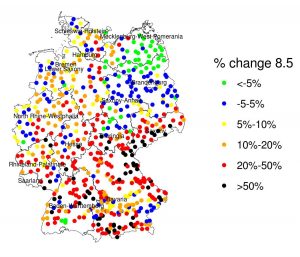In this post, Trong Dieu Hien Le talks about their recently published paper “Predicting current and future background ion concentrations in German surface water under climate change”.
Salinisation of surface waters is a global environmental issue that poses risks to freshwater organisms, potentially leading to high environmental and economic costs. Climate change can accelerate natural salinisation processes (i.e. increase background ion concentrations), thereby increasing the salt load of water bodies. Future climate change projections for Central and Eastern Europe forecast an increase in temperature extremes such as an increase in the duration and intensity of droughts. This may exacerbate salinisation and also result in interactions with other stressors. For example, increasing salinity was a major factor controlling the invasion of alien species (molluscs and crustaceans) in German streams.

Percent change in mean electrical conductivity under scenario Representative Concentration Pathway RCP8.5 (graphic by TDH. Le)
In this study, we used a large spatial dataset to predict individual ion concentrations and electrical conductivity (EC – a proxy for total dissolved solids) in German running water bodies. Predictions were driven by the major factors controlling salinity including geologic and soil properties, climate, vegetation and topography. Not surprisingly, the factors most strongly associated with stream ion concentrations were rock chemistry and climate. Our forecasts show relatively minor average increases (approximately 10% to 15% increases in mean EC), but regionally values may increase by more than 50% with potentially serious ecological consequences.
The paper authored by Trong Dieu Hien Le, Mira Kattwinkel, Klaus Schützenmeister, John R. Olson, Charles P. Hawkins, and Ralf B. Schäfer is part of the theme issue ‘Salt in freshwaters: causes, ecological consequences and future prospects’, journal Philosophical Transactions B.
